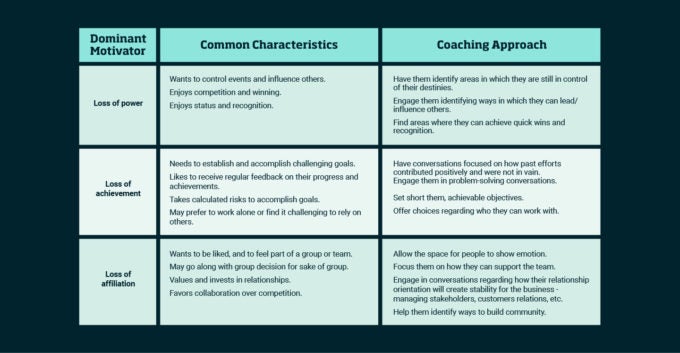Coach your people to switch from 'survive' to 'thrive' mode
Understanding what motivates your people can help you connect with your staff and prevent them from becoming disengaged as they contend with the uncertainty wrought by the pandemic, write IMD's Michael Watkins and Brenda Steinberg
This article is republished with permission from I by IMD, the knowledge platform of IMD Business School. You may access the original article here.
After more than 18 months of working in a crisis, employees are exhausted, morale is low, and there is no end to the upheaval in sight. With the Delta variant pushing up infection and hospitalisation rates and delaying proposed return-to-the-office dates, managers may be struggling with how to keep the motivation and energy of their staff from sagging, as they schedule yet another Zoom meeting.
On 9 September, Microsoft postponed its plans to reopen its headquarters, following on from Google, Amazon, Facebook, Ford and Uber that have also extended working from home policies. As people’s bedrooms and living rooms become their offices, the fuzzy line between personal and professional lives may be taking its toll. Other organisations from Goldman Sachs to Johnson & Johnson have mandated vaccines for certain employees. Staff who have grown accustomed to working outside the office may fret that they will be penalised by their employer if they decide they want to permanently work from home.

While it may be tempting to try and move your business on from the pandemic, it is important to remember that everyone’s experience of the COVID crisis has been different, and many will be feeling great uncertainty about their futures. So, even if you experience a strong desire to try to put the pandemic behind you, temper that with a focus on coaching your people to navigate through this new normal. There may be no magic bullets, but there are a few things that can help your staff start to thrive rather than just survive.
- Be emotionally available. First and foremost, your people need to know that you understand what they are going through. As the crisis drags on, remember to keep checking in often, monitoring moods, and paying attention to what they are talking about. That way, you will be able to anticipate and directly acknowledge their worries and fears, even if you don’t have all the answers.
- Separate fact from fiction. Help your people not get distracted by false information. If a rumour surfaces, ask where it comes from until you know the source. If your people are making unfounded assumptions – optimistic or pessimistic – explore what they are basing their assumptions on and help them see the bigger picture.
- Be an optimistic realist. Focus your people on what really is and is not likely to change. Challenge them to find realistic ways of making lemonade out of lemons. But don’t sugar-coat the situation, or people will lose faith in you. Help them see the areas to which they are still able to contribute.
- Temper their urge to over-react. Help keep things as stable as possible. Crisis brings out the latent manic-depressive in many people. They are up, they are down, they are all around. It’s your job to stay calm and talk people off the ledge. This applies to you too! Strive to strike the right balance. If you are too emotional, there is no security. If you are too calm, they will think you are not taking the crisis seriously enough.
- Figure out what is still worth doing. With the pandemic proving every meeting doesn’t have to be held in person, figure out what aspects of your business’ crisis operations are worth keeping. Regardless of how bad things look, there still have to be battles worth fighting, even if it is just to get a personal sense of closure. So figure out what those must-win battles are and focus your people on them.
- Focus on the short term. While many lament that businesses have too much short-term orientation, a crisis is a time when it makes sense to focus on what can be done now. Ask what hat are we going to do in the next week, two weeks, month? Focus on what can be kept and what can be scrapped.
Read more: Learning from crises: six critical leadership lessons
Coaching for motivation
Critically, as you coach, your people stay motivated, focus first on understanding what is demotivating for them, and adjust your approach accordingly. To do this, it helps to have a framework for understanding motivation and the implications for leading during a crisis. The one we have found to be most useful for coaching in crisis situations was developed by the motivational psychologist David McClelland and distinguishes among peoples’ needs for power, achievement, and affiliation, as summarised in the table below.

People are usually motivated by more than one of these, but one is likely to be dominant. So, focus first on understanding what that is, based on what you know and have observed, and then coach accordingly. When leaders coach their direct reports, it is an opportunity for both the leader and the direct report to learn. Coaching is the opposite of knowing; knowing gets in the way of learning. In other words, don’t feel like you need to be the expert before engaging in meaningful conversations.

Preparing yourself
As you seek to help coach your people to stay motivated, you can find yourself caught in an emotional vice. Even as you try to put on a brave face to deal with distress in your team, you have to cope with the potential impacts on your own life and livelihood. Even you try to set goals and motivate people to attain them, your own morale may be deteriorating.
- Coach yourself. The first step is to ask yourself, what motivates you? Which of the box(es) above are you in? For example, if you feel like you are motivated by power, and you lack control and influence, how might you set short-term objectives to organise others? Can you identify areas that you are in control of right now, and do not need permission from others to act on? And then, how might you bring attention to the work you and your team are doing? Alternatively, if your need for achievement is strong, and you find yourself paralysed by the risk of failure, you may need to ask yourself, what are you really afraid of? What are the consequences, both positive and negative, of retreating? As a result of the self-reflection, do you have new insights? How can you put them into action?
- Reframe to energise. If you usually are not motivated by coaching or get depleted by having to focus all of your energy on others, try to reframe the situation. If, for example, you are driven by achievement but have many people on your team who have high needs for affiliation, reframing may help you find the energy to give them what they need. Framing the situation as “By helping people find ways of connecting, they will be better able to meet deadlines, and I will be able to have more time to work on the strategy” may be more motivating for you than “I need to spend the next hour talking to people."
- Identify your blind spots. Once you identify your motivational needs, you need to identify your blind spots. Even if intellectually, you understand that people have different motivations, you may still act like others are motivated by the same things you are. For example, if you are driven by achievement, you need to be specially prepared to listen for power and affiliation.
- Focus your attention. Who most needs you right now? What do you know about this person? What do you think motivates them? How do you normally engage? When you have had productive conversations in the past, what made them productive? The first step in coaching is about connection and trust-building. You want to draw on past experiences to set the tone of the conversation, the place, and the timing. Conversations do not have to be long and can use a wide variety of communication methods, including virtual and texting (especially for younger workers).
- Be curious. Many leaders are hesitant to coach or have deeper conversations for fear that they won’t be able to deal with others’ distress. You may be afraid that you will identify more problems or expectations or that you don’t have the skill. Keep in mind that the purpose of coaching is to help people tap into their motivations, explore possibilities, and find their own solutions.

Having coaching conversations
No one is expecting you to be a professional coach, so don’t overthink it. This is a chance for you to connect with your people. All you need to do is be curious, listen, and ask good questions pertaining to what is on the person’s mind. By keeping your focus on the person, you are showing empathy. That doesn’t mean you can’t challenge perspectives by asking if there are other ways to look at the current situation and yet still show you care. You can also add new information and ask how this new information relates to them. People who can find their own solutions, unique to them, are more motivated to act.
In a crisis, your people will appreciate your efforts to have meaningful conversations. That in itself can tap motivation.
Michael Watkins is Professor of Leadership and Organisational Change at IMD. He is the author of The First 90 Days, Master Your Next Move, Shaping the Game, and numerous other books and articles on successfully taking new roles. Brenda Steinberg is an executive coach and contributes regularly to executive education programs at IMD and works as a consultant with Genesis Advisers.
